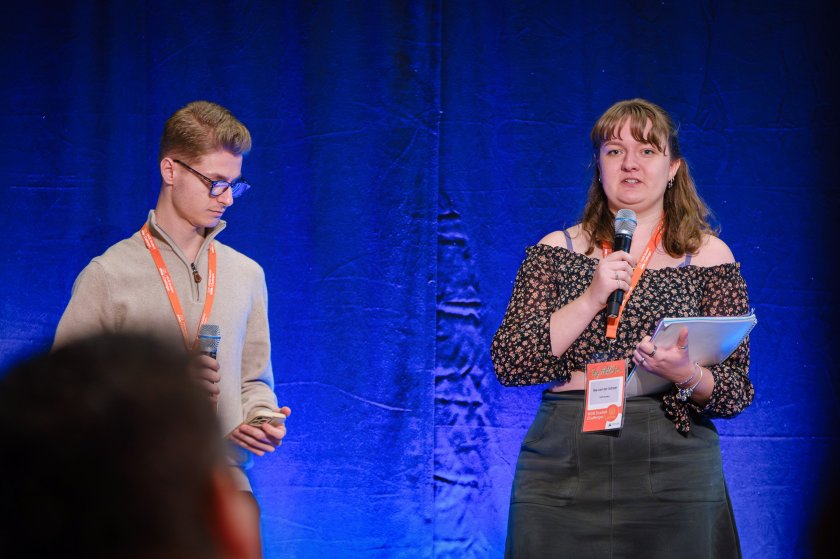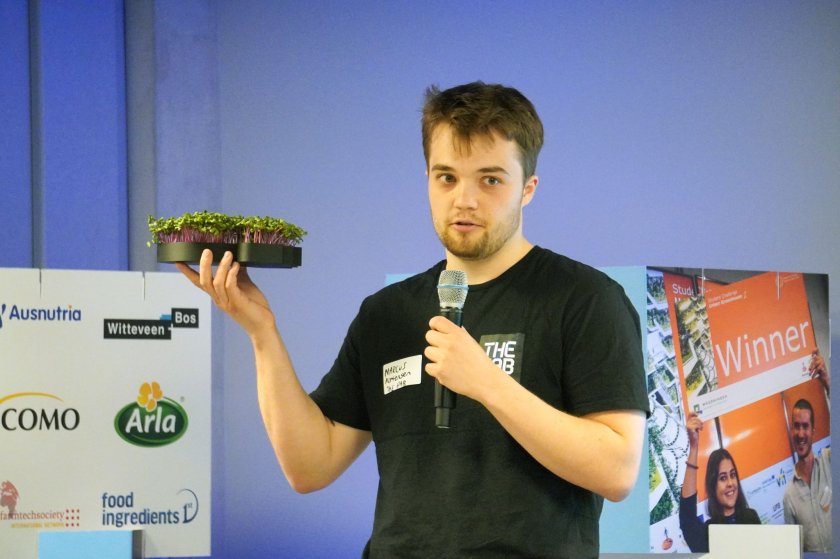
category_news
Students design agricultural innovations inspired by space technology
Ten student teams remain out of the forty-four that started the ReThink Food Challenge. Each has developed a startup concept around the theme of space agriculture. But this isn’t escapism: their innovations are meant to contribute to sustainable food production on Earth as well.
Why should agriculture be inspired by the International Space Station? Master's student Ilse van der Scheer (26) has an answer ready: “Space farming is highly innovative. The space station, for example, is very circular—everything is reused. After all, you can’t launch a rocket with supplies every week.” Van der Scheer is a member of team Cyanotreats, one of the ten teams that made it to the Grand Finals of the Challenge. The finale takes place on May 27, featuring a presentation by an engineer from the European Space Agency and a total prize pool of €13,000.
The ReThink Food Challenge is not just about a hypothetical future where humanity moves to Mars, but about innovations that can bear fruit on Earth right now. “The constraints of space farming were intended to inspire the participants to develop sustainable innovations,” explains Marta Eggers, project leader of the Future Food Challenge. “How can you minimize waste through smart recycling? How can you produce food with limited resources? What technologies already used by astronauts can also make a difference on Earth?”
From urine to protein
In the novel and film The Martian, astronaut Mark Watney uses his own excrement to fertilize potatoes on Mars. The six students of team Cyanotreats designed a similar reuse system—but with urine. “Urine still contains many valuable nutrients,” explains Van der Scheer, who studies Biotechnology at Wageningen University & Research. “We propose growing blue-green algae in it—in other words, in wastewater. These cyanobacteria, as they are formally known, feed on the nitrogen in the urine, CO₂, and light, and convert that into protein.”

A filtration, purification, and drying process harvests the algal cells, removes all wastewater residue, and turns the cells into a usable protein powder that can be incorporated into a variety of food products. It also contains vitamins and other beneficial substances produced by the algae. “It’s an alternative source of protein that takes up little space, requires minimal resources, and even recycles a waste stream,” Van der Scheer proudly emphasizes. “Our system can be set up in space, but also in the most inhospitable places on Earth.”
Gels for greenhouse horticulture
Team The Hab took inspiration from an agricultural method already used by astronauts: hydrogel. This gelatinous material consists mostly of water and is used to grow plants. “Couldn’t that material be used in greenhouses?” wondered Marcus Mortensen (22), a student at the Norwegian University of Life Sciences. “Any student interested in indoor farming learns that peat—the material plants are often grown in—is on its way out, and that sustainable alternatives are in high demand. Our hydrogel, Astrogel, offers such an alternative.”
Unlike the gels Mortensen and his team encountered in academic literature, Astrogel is entirely plant-based. Its main ingredient is agar, a jelly derived from red algae. “That makes Astrogel not only recyclable and biodegradable, but also edible.” Though Mortensen quickly adds it doesn’t taste like anything. He cooked up the first prototype himself on a Friday. “I planted some microgreens in it. When I checked the container again after the weekend, I saw the seeds had not only germinated—they were growing quite well.”

At the moment, Astrogel is only suitable for seedlings and microgreens. “These can grow using just the water already present in the gel,” Mortensen explains. “Although hydrogels contain a lot of water, they don’t absorb it well. We're currently working on solving that, so larger plants could eventually be grown in Astrogel too.”
A handful of business cards
A good prototype alone isn’t enough. The students are ultimately judged on a complete business plan. In essence, the Student Challenge invites them to conceptualize a functional startup—something winning teams often go on to actually launch. Morgan Timme (29), a master’s student in Resilient Farming at Wageningen, says The Hab has already made contact with a seedling producer and a Michelin-starred restaurant. “After demonstrating our product during the Challenge’s demo day, we went home with a handful of business cards.”
“But we don’t only see large-scale applications,” Timme continues. “Astrogel can easily be made at home—just add water. So consumers could very simply grow nutritious microgreens at home. It’s not only healthy but also a fun way to reconnect people with modern agriculture and the food system.”
The winner of the ReThink Food Challenge final will go home with €7,000—a first capital injection to help make their startup a reality. The entire top three will present their innovations at GreenTech Amsterdam, a conference focused on sustainable greenhouse horticulture, agriculture, and food production.